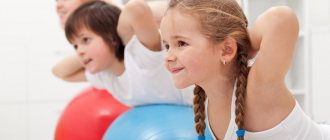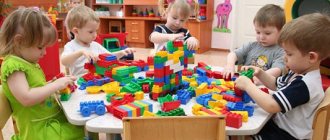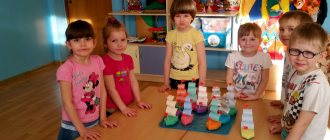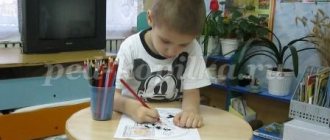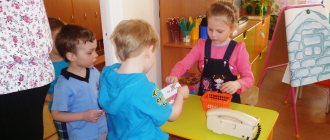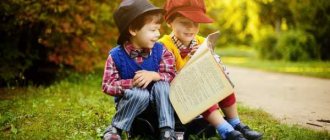Consultation for teachers “Organization and conduct of morning reception in kindergarten”
Organizing and conducting morning reception in kindergarten
Goals and objectives of the morning reception:
Goal: Gradual entry of the child into the life of a child, creating a calm psychological comfortable mood in each child, strengthening the intimate and personal contact of the teacher with each child.
The main tasks of the morning meeting are:
- establishing a comfortable social and psychological climate in the children's team through free communication with peers.
- development of independence, self-organization.
Additional tasks:
- Forming friendly relationships between children, creating an atmosphere of support and cooperation between children and adults, creating a general positive emotional background, and a feeling of psychological comfort.
- Give children the opportunity to speak out and listen to each other, empathize with each other.
- Give new information.
- Solving some educational problems (expanding children's ideas, developing speech, logical thinking, etc.)
- Maintaining a new topic.
- Get information about children's development, their interests and other characteristics.
- Formation of motivation.
- Organization of planning of children's activities.
- Solve some socio-psychological problems (organize the choice of partners).
- Enjoy.
Reception of children starts at 7600 and lasts until 8-8 hours 30 minutes. To prepare for receiving children, the teacher must come to the kindergarten in advance. You can welcome babies both outdoors and indoors. If there is a site in good weather during the warm season, it is better to receive children in the fresh air.
Before welcoming children into the group, ventilate the room. According to the data developed by SanPiN, the duration of ventilation is calculated taking into account the following indicators: room area; air temperature in the room; weather.
The daily morning reception of children is carried out by educators and (or) medical workers who interview parents about the state of health of the children. According to indications (in the presence of catarrhal phenomena, signs of intoxication), the child is subjected to thermometry. Data about the child’s condition is entered into a special journal, in which parents sign if they agree with the results of a visual examination of their children. Identified sick children or children with suspected illness are not accepted into preschool educational organizations.
A child who is absent for more than five days (except for weekends and holidays), as well as after an illness, is admitted to the preschool institution with a certificate from the local pediatrician. The certificate must indicate the diagnosis, duration of the disease, information about the lack of contact with infectious patients.
Play activity
- The teacher prepares games and toys, arranging them in such a way that it is convenient for children to take them and play without interfering with each other.
- The teacher encourages games that arise on the initiative of the children themselves, helps to implement their plans, creating the necessary conditions for this, and creates conditions for the development of creative games.
- He can offer children a variety of educational games that are already familiar to them.
- The teacher also offers outdoor activities, which are carried out both on the site and indoors.
Labor activity of children
- At a young age, the teacher involves children in caring for plants and animals (watering flowers, feeding fish), invites them to change clothes for a doll, etc. The kids carry out work assignments under his supervision and with his help.
- At an older age, children are on duty in a corner of nature. At this time, you can also conduct various observations with children (with the whole group and individually) on the site and indoors: of the work of adults, of natural phenomena, etc.
Individual work
In the first half of the day, the teacher does a lot of individual work with children:
- organizes special games and exercises with those of them who need to correct speech deficiencies - work on: correcting and educating children in correct sound pronunciation; development of oral speech and development of correct intonation, etc.
- organizes physical education work with children lagging behind in any movements.
- works with inactive and withdrawn children, giving them various tasks that require communication with adults and peers (for example, going to the kitchen and asking for vegetables for the guinea pig).
- Children who are not inquisitive enough are entrusted with interesting observations (for example, how a hamster eats and puts grains in its cheeks, tits that have flown to the site, admiring the beauty of a winter morning, etc.).
Working with parents
Remember that your child and his interests should always come first. Adults will always wait. Of course, you need to say hello and talk to adults every day, but if at the moment you are concerned about the safety or behavior of the children, then ask the junior teacher to take care of them urgently, or, after apologizing, avoid talking with the adult.
Individual conversations can take place at the initiative of the teacher or the parents themselves.
Thank you for your attention!
Analysis of routine processes in the senior group in the first half of the day
CONCLUSIONS:
1. Analysis of regime processes.
The group has created all the conditions for the full implementation of regime processes. Reception of children is carried out in the dressing room, where there are lockers for the number of children, a sofa and benches for changing clothes, a mirror so that children can eliminate the mess in their appearance (the mirror is at the height of the children, securely fastened). Each child has a personal comb, spare clothes, and clothes for physical education in their locker.
The group has also created all the conditions for a child’s safe and comfortable pastime: equipment and toys are within reach of children, supplies for duty are in a certain place, children freely take them from there and put them back at the end of duty.
The washroom is equipped with everything necessary: there are several sinks, which does not create a crowd when washing hands; mirrors, towel hangers. Everything is freely accessible.
The group has enough cups for drinking, linen (it is changed in a timely manner, according to the schedule), tables, and chairs. In the group there is unity of requirements for children, the actions of the teacher are coordinated with the actions of the assistant teacher. The teacher conducts conversations with parents on the topic “Daily routine in kindergarten and at home”, gives advice to parents on how to bring the home routine closer to the kindergarten routine. Thus, the teacher achieves unity of requirements for the child.
The daily routine ensures that children's activities are meaningful; a favorable environment reigns in the group, there is no noise, no commotion, and children clearly fulfill the requirements of the routine.
The daily routine is of a certain nature, i.e. is subject to a number of rules that children adhere to: rules for using toys and things that determine the relationship between children and adults (for example, play together, do not take away toys, do not offend each other). The requirements arising from the regime are understandable to children; this disciplines children. It can be seen that the daily routine in the group meets the requirement of consistency: children carry out certain routine processes without whims and by a certain time they already feel the need to switch to a new routine segment. The daily routine in a group is appropriate, since all the requirements of the routine have a certain meaning, necessary and conditioned by the general goal and objectives of education.
2. Techniques for creating interest in regime processes.
During the first half of the day, the teacher uses a variety of techniques to create interest in routine processes. The main technique is gaming. The teacher also resorts to playful techniques when the child is not eating well. The teacher also uses artistic words with humor when it is necessary to draw the child’s attention to his mistake when washing and reading a fairy tale when putting the children to bed. All this undoubtedly creates children's interest in routine moments.
